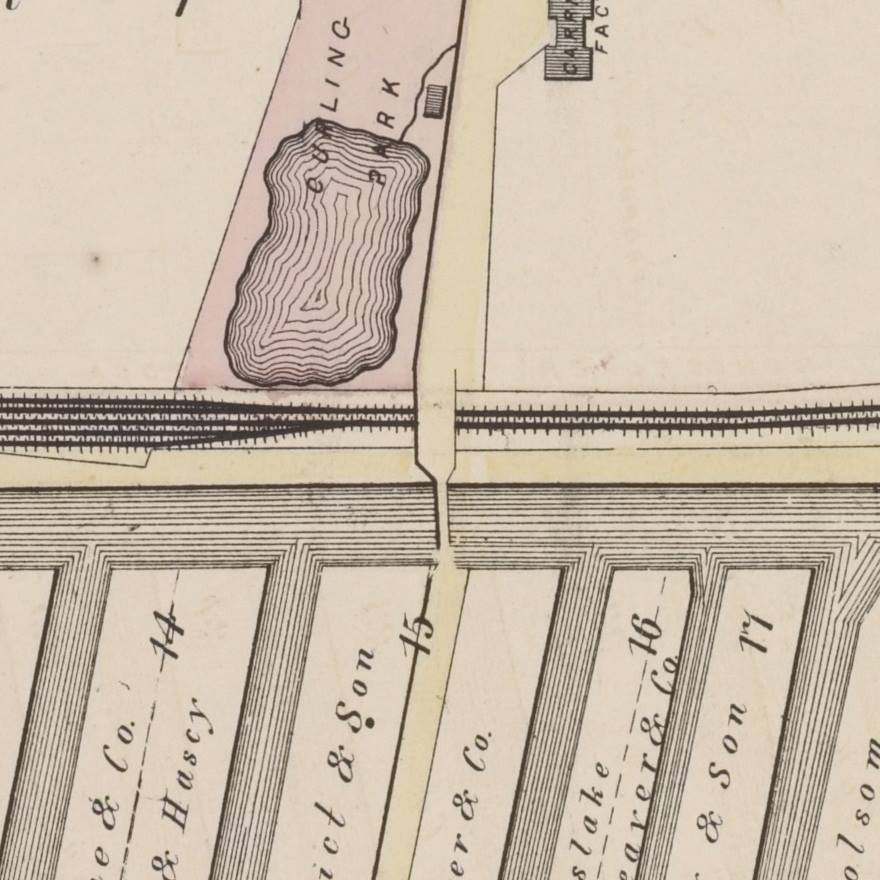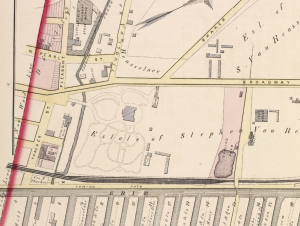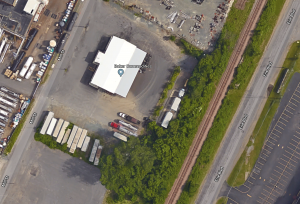 Stare at an old map long enough, and eventually you’ll be faced with a mystery you have to solve. We’ve stared at the Hopkins map of Albany from 1876 more than a sane person should admit, and every now and then a little detail jumped out at us, calling for attention. We ignored it any number of times, until finally it became clear we had to figure it out. What the heck was the Curling Park?
Stare at an old map long enough, and eventually you’ll be faced with a mystery you have to solve. We’ve stared at the Hopkins map of Albany from 1876 more than a sane person should admit, and every now and then a little detail jumped out at us, calling for attention. We ignored it any number of times, until finally it became clear we had to figure it out. What the heck was the Curling Park?
It’s on the map on the north side of the city, across the canal and railroad tracks from the lumber district, part of what was then still the Stephen Van Rensselaer estate before that area became industrial. But was curling a thing in Albany? It was, but the “park” was used for much more than that.
The earliest reference we’ve found to what was called the Van Rensselaer Skating Park (though it appears to have had no connection to the Patroon other than its location) was in 1861, with an advertisement in the Argus proclaiming that the park would commence its season December 1, 1861 and end March 1, 1862. But it had been open at least one year prior: “In opening the Park for the Season, the Directors solicit from the Public the same generous patronage extended to them last year, and pledge themselves to conduct in a manner calculated to give satisfaction to all.” Gentlemen’s season tickets were $4.00; ladies and children under 12 years, $2.00. “Subscribers will be allowed to introduce Ladies by paying 25 cents for each admission. On evenings designated for Carnivals, an extra charge will be made.”
Weather allowing, the park was to be open daily except Sundays from 9 AM to 10 PM. Of course, one wouldn’t want to go all the way up there to find out what the ice was like, but the 19th century had a system: “The condition of the ice may be known by a RED BALL hoisted upon the Staff at the foot of State street by day, and a COLORED LIGHT by night.” Stages left the Capitol and Exchange (the old Federal building at State and Broadway) every half hour from 1 to 8-1/2 PM. Trains on the “Northern Railroad” apparently also stopped there, with 5 departures each direction each day. Fare for either stage or train was five cents. Tickets were available at Newcomb’s at 524 Broadway, Lathrop’s at 57 State Street, or at the Park.
Van Rensselaer wasn’t the only skating and curling park. Another one called “The Orr Union Skating and Curling Park, known heretofore as Buttermilk Falls,” was also open in 1861. Family season tickets were only one dollar. We’re entirely unclear as to the location; the entrance was given as from Eagle street. “The above Park will be in charge of Relief Engine Co. No. XI, and a Special Officer appointed by the Mayor will be in attendance to keep order. There is a building erected for Refreshments, and a separate room for Ladies. The best of order will be kept. Open from 9 A.M. to 10 P.M.” Tickets were available at Fleming’s Segar Store, South Pearl and Beaver streets, and George Stevens’, corner of Bleecker Place and Eagle. (Paula Lemire was good enough to remind us that Buttermilk Falls was within what is now Lincoln Park, and so this skating park was likely somewhere around the bowl of the park.)
Van Rensselaer was still open in 1863, when the opening of the skating season was noted:
“The Van Rensselaer Skating Park was opened for the season yesterday [Dec. 7, 1863], to the great delight of innumerable young ladies and gentlemen. The sight of the welcome signal flag floating in the breeze caused no small degree of joy among those who could live on skates.”
Both the aforementioned Lathrop and the Erastus Corning Co. sold a variety of skates. Lathrop claimed the largest assortment in the city, “among which are The Skowhegan Skate, The Norwich Clipper, The Blondin Skate, The Philadelphia Club Skate, The New York City Club Skate, and Dutton’s Shell Groove Skate.” Corning advertised skates and sleigh bells together; perhaps they were used together.
In 1866, live music was added: “The managers of the Van Rensselaer Skating Park begin to-day a new style of entertainment. Schreiber’s band will furnish music to the skaters this afternoon from three to six o’clock at no extra charge to season ticket holders, while the public generally are admitted at the moderate price of 25 cents. This novelty should prove a success, and we hope that it may do so.”
The Van Rensselaer Skating Club put the park up for sale in the summer of 1867: “Proposals will be received by the Van Rensselaer Skating Club for the sale of all the property belonging to the said Club, and located upon the Park Grounds, north of the Van Rensselaer Mansion, consisting of Buildings, Fence, Iron Pipe (about 800 feet), Ice Planes, Snow Plows, Torches, Colored Lanterns, Liberty Pole, Flag, &c.” They were offering either all or any portion of the property, or to sell it “with a view of continuing the use of the Park for Skating purposes.” While we found several notices of the sale, we don’t find if the Park was actually sold; we just know that it continued on.
Before we even get to a mention of curling proper, we find an odd mention of a baseball game to be played at the curling park – on skates. On February 9, 1865, the Argus wrote: “It is expected that the return match of base ball on skates, between the Nationals of this city, and the Washington Club of Troy, will be played on the Van Rensselaer Skating Park this afternoon.” Perhaps this was an exhibition or a novelty, but we found another game that was played similarly on Feb. 12, 1868: “The match game of base ball played on the Van Rensselaer Skating Park yesterday afternoon between the Knickerbockers and Nationals of this city, resulted in favor of the latter club by a score of 58 to 10; but four innings being played.”
Dec. 12, 1868 is the first time we find mention of a formal curling club, but again it’s clear they had been around in previous years:
“The Albany Curling Club have commenced operations for the season, their first game being played Thursday, on their rink, adjoining Van Rensselaer Skating Park. They enjoyed the game very much, and will be at it every afternoon when the ice is in order. Curling is peculiarly a Scotch game; but as Scotchmen are to be found all over the globe, it is not to be wondered at that they should introduce their favorite game in countries such as this, where ice suited to the game is so easily obtained.”
There followed a detailed description of how curling works. Interesting that it said the curling rink was adjoining the skating park; perhaps they had once been one and the same. When the skating season opened that December, the Albany Morning Express said that heavy snow had caused a delay in opening the rink. “Lively times at the park may then be expected, as there is no other place for skating in this vicinity.”
In 1872, The Troy Daily Whig noted that the International Curling Club would be hosted by the Albany Curling Club. “This Club will meet at the Albany Board of Trade Rooms at 5 o’clock this evening [June 11, 1872]. The delegates from abroad will be entertained by the Albany Club at the Delevan House. To-morrow, at noon, the quoit prize will be contended for on the Albany Curling Club grounds.” The article also referred to a Grand National Curling Club.
That’s about the last mention of the skating park that we’ve found. Perhaps not coincidentally, the Van Rensselaers moved out of the manor house about 1875, as the area industrialized. We’d love to know if there was a connection.
In modern terms, the curling park was located across the canal (Erie Boulevard) and the railroad tracks from what is now Huck Finn’s warehouse. Google Maps has it as occupied by a company called Baker Commodities, a rendering and grease removal service. We’re sure they have no idea their recycling operations were once the site of one of old Albany’s great pleasure centers.



The Grand National Curling Club is the umbrella organization for all of the U.S. East Coast clubs. It runs tournaments and such. While the Albany Curling Club did not operate continuously since the 1860s, the GNCC has.
Thanks, Laurie. What was confusing to me was that the article first referenced the International Curling Club, then talked about the Grand National, and made them sound like the same organization from the way it was written, which didn’t make sense to me.